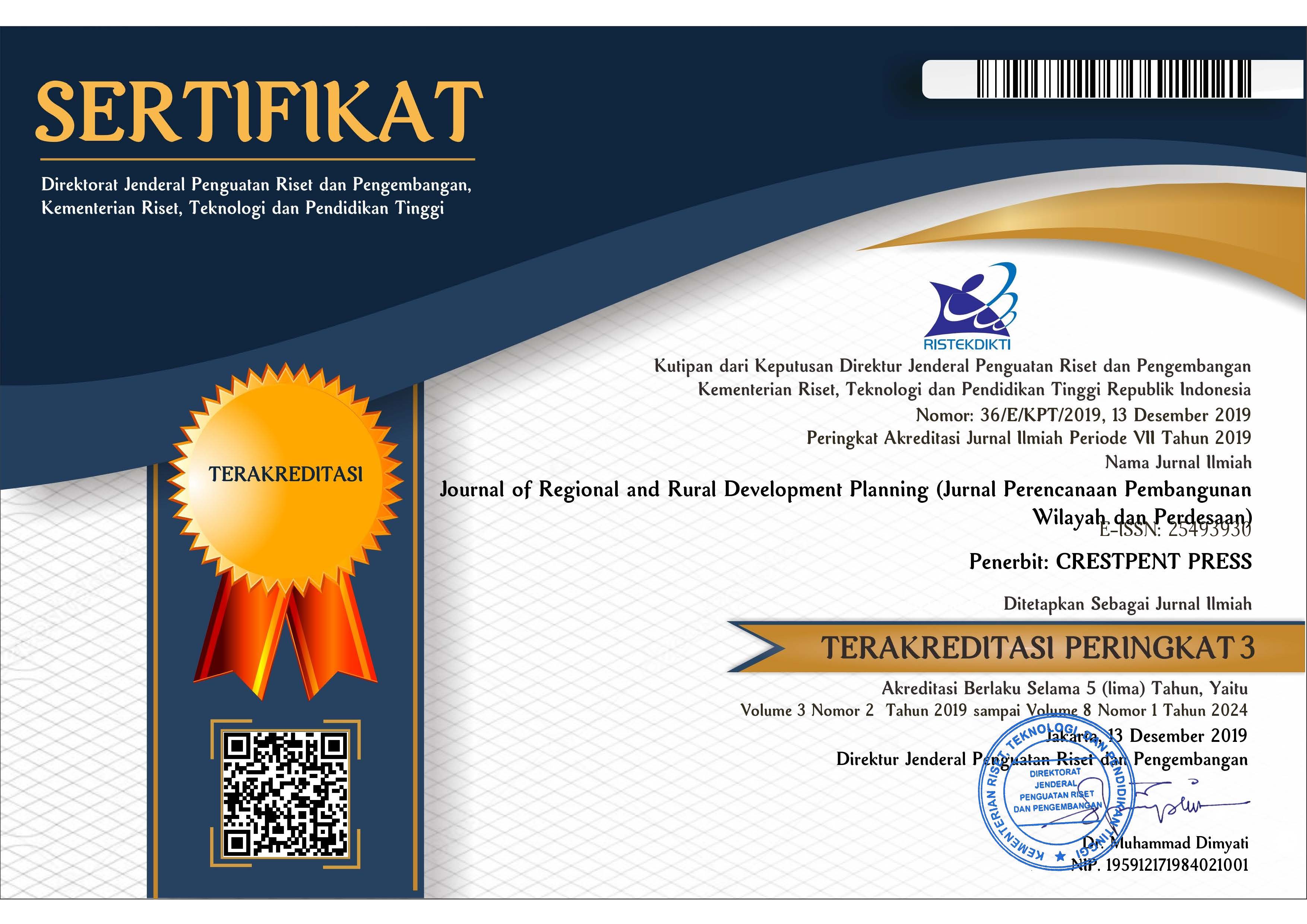Model Perencanaan Kawasan Pertanian di Kabupaten Karangasem, Provinsi Bali Pasca Erupsi Gunung Agung
Abstract
Karangasem is one of the regencies in Bali Province that has potential in the agricultural sector, in addition to Tabanan Regency. Contribution of the agricultural sector of Karangasem Regency amounted to 14.74% of the GDP of Bali Province. Large potential of the agricultural sector can also be seen from the livelihoods of the population, where majority (50.61%) work as farmers (Statistics of Bali Province, 2017). In November 2017, Mount Agung erupted, impacted the development of sectors in Karangasem Regency, including the agricultural sector. This research is intended to determine the competitiveness of the agricultural sector (especially the food crop subsector) and the planning model of agricultural areas in the regency. Location selection is done purposively with the consideration that it has the lowest economic growth rate after Jembrana Regency and has experienced Mount Agung eruption in 2017. Research method used are Shift Share Analysis and Dynamic Modeling. Especially for Dynamic Modeling, an analysis of economic aspects was carried out. Results shows that agricultural sector in Karangasem Regency can still compete with other regions in Bali Province. The agricultural sector, especially paddy fields in the last five years (in 2012-2017), was still able to contribute to the increase of the regency's Gross Regional Domestic Product (GRDP) and community income if the agricultural area management model is implemented in an integrated manner between farmers, Village Credit Institutions, and local customary villages.
References
(2017). Bali dalam Angka 2016. Denpasar (ID): BPS.
[BPS] Badan Pusat Statistik Kabupaten Karangasem. (2017). Karangasem dalam Angka 2016. Denpasar (ID): BPS.
Dewanti, A., Budi, E. (2011). Penentuan Alternatif Lokasi Pengembangan Kawasan Agroindustri Berbasis Komoditas Pertanian Unggulan di Kabupaten Lamongan. Jurnal Teknik Sipil ITS, 1 (1), 33-37.
Dewi, P. dan Santoso, E. B. (2014). Komoditas Unggulan Sektor Pertanian di Kabupaten Karangasem Melalui Pendekatan Agribisnis. Jurnal Teknik Pomits, 3 (2), 184-189.
Ekasari, M. (2011). Perencanaan Pengembangan Sektor Pertanian dalam Upaya Meningkatkan Perekonomian Kabupaten Temanggung. Jurnal Fokus Bisnis. 13 (1), 31-40.
Hamzens, W. (2011). Pengembangan Kawasan Pertanian di Kabupaten Sigi Provinsi Sulawesi Tengah. Jurnal Ruang. 3 (1), 55-62.
Hermawan, H. (2016). Dampak Pengembangan Desa Wisata Nglanggeran terhadap Ekonomi Masyarakat Lokal. Jurnal Pariwisata, 3 (2), 105-117.
Hoover, E. M. dan Giarratani. (1985). An Introduction to Regional Economics. Third Edition. Knopf, New York, 115-117.
[Perda] Peraturan Daerah Propinsi Bali Nomor 3 Tahun 2007 tentang Lembaga Perkreditan Desa (LPD).
Lobe, K., Fikret, B. (2004). The Padu System of Community Based Fisheries Management: Change and Local Institutional Innovation in South India. Marine Policy, 28 (3), 271-281.
Milenkovic, S., Svetlana, U. (2013). The Challenges of Rural Areas in Serbia Promising Tourist Activities. Economic of Agricultural, 6 (1), 65-76.
Murdiyanto, E. (2011). Partisipasi Masyarakat dalam Pengembangan Desa Wisata Karanggeneng, Purwobinangun, Pakem, Sleman. Jurnal Sosial Ekonomi Pertanian dan Agribisnis, 7 (2), 91-101.
Powell, R., Ham, S. H. (2008). Can Ecotourism Interpretation Really Lead to Pro-Conservation Knowledge, Attitudes and Behaviour? Evidence from the Galapagos Islands. Journal of Sustainable Tourism. 16 (4), 467-489.
Riyadi, S. (2006). Banking Assets And Liability Management. Jakarta: Lembaga Penerbit Fakultas Ekonomi Universitas Indonesia, 186-187.
Scheyvens, R. (2009). Ecotourism and The Empowerment of Local Communities. Tourism Management, 20 (2), 245-249.
Sterman, J. (2000). “Business Dynamics: System Thinking and Modeling for a Complex World”. Singapore: The McGraw Hill Companies, 78-79.
Susilastuti, D., Putrawan, I. M., Hanny, W. (2009). Model Hubungan Penduduk dan Konversi Lahan dengan Ketersediaan Air Bersih untuk Perencanaan Pengelolaan Sumberdaya Air Melalui Metode System Dynamics di Kabupaten Bekasi. Jurnal Bumi Lestari, 9 (2), 138-150.
Setiyanto, Adi. (2013). Pendekatan dan Implementasi Pengembangan Kawasan Komoditas Unggulan Pertanian. Forum Penelitian Agro Ekonomi, 31 (2), 171-195.
Terluin, I. (2003). Differences in Economic Development in Rural Regions of Advanced Countries: An Overview and Critical Analysis of Theories. Rural Studies Journal, 19 (2003), 327–344.
Wiagustini. (2014). Model Pemberdayaan Lembaga Perkreditan Desa (LPD) Sebagai Sumber Pendanaan Usaha Mikro Kecil Menengah (UMKM) di Kabupaten Gianyar. Jurnal Manajemen Strategi Bisnis dan Kewirausahaan, 8 (1), 17-25.
Wicaksono, I. A. (2011). Analisis Location Quetient Sektor dan Subsektor Pertanian pada Kecamatan Purworejo. Jurnal Ilmu Ilmu Pertanian, 6 (1), 11-18.
Copyright (c) 2019 Journal of Regional and Rural Development Planning

This work is licensed under a Creative Commons Attribution-ShareAlike 4.0 International License.




.png)














